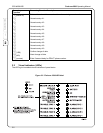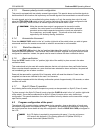
E
D
C
B
4
5
A
3
CPG #2561255 FIRELARM 2500 Operating Manual
3-3
3.4 Wiring
Refer to Figures 3-5 through 3-7 for wiring information.
1. Install all required conduits, external wiring. With the AC power turned off at the circuit breaker panel,
connect the 120VAC hot (black), neutral (white) and ground (green) wire to the panel as shown on
the power supply connection drawing (Figure 3-7).
2. If not already done, install the main board into the cabinet and connect the transformer secondary
leads to connector P2. Turn the AC power on and connect the standby batteries with the cable
provided to connector BAT 1, while observing polarity. Verify that the panel goes into normal standby
condition.
3. Connect each circuit individually and verify the operation of the circuit as outlined in section 5.2
Inspection and test procedure.
4. Inactive circuits: All inactive initiating device and indicating circuits must have the end of line test
resistor on the panel terminals. On circuits that have four terminals the resistor must be on the
outside two terminals.
3.5 Quick Reference Operating Instructions form
Make a photocopy of the form in Appendix E. Fill in the name, address and telephone number of the
servicing agency on the bottom of the form and post in a prominent place.
3.6 Zonal Digital Alarm Communicator Transmitter (optional ZDACT)
Remove AC power and battery power from the panel. Line up the electrical contact socket on the ZDACT
with the pins on connector J8 on the panel. Firmly insert the ZDACT into the pins.
Connect the primary and secondary phone lines to the phone jacks. Peel off the small adhesive label at
the edge of the large black plastic LED label so that the ZDACT LED's can be viewed from the front.
Reconnect AC power and battery power.
3.7 Battery size requirements
Using the Calculation Table (Table 3-3):
1. List in column #1 all devices used in the system; include all modules, NAC, horns, strobes, door
holders, and 4-wire smoke detectors (see Table 3-1 or manufacturer’s specifications).
2. List in column #2 the quantity of each device.
3. List in column #3 the standby current of each device (exclude all signal notification appliance circuits).
4. List in column #5 the alarm current of each device.
5. For each line multiply the figure in column #2 by the figure in column #3 and enter the product in
column #4. Then multiply the figure in column #2 by the figure in column #5 and enter the product in
column #6.
6. Add the figures in column #3 and #6 and enter the sums in the appropriate total mA box.
7. Convert these figures from milliamperes to amperes by multiplying by .001 and enter the product in
the appropriate total A box.
8. Multiply the standby total amperes by required time in hours from Table 3-2.
9. Divide the alarm total amperes by 12 (5 minutes).
10. Add the standby AH and the alarm AH and divide this sum by .85 (efficiency factor). Select a battery
that has an AH rating above this figure but not less than 6.5AH.
The FireLarm 2500 cabinet can hold batteries up to 7AH. If a larger battery
is needed, use a separate battery cabinet (must be UL Listed for Fire
Protective Signaling Use). Any auxiliary battery cabinets must be mounted
adjacent and close-coupled to the FireLarm 2500 cabinet. All battery power
wiring must be securely segregated from nonpower-limited wiring (see Figure
3-7). The maximum battery capacity that can be used is 44AH.


















